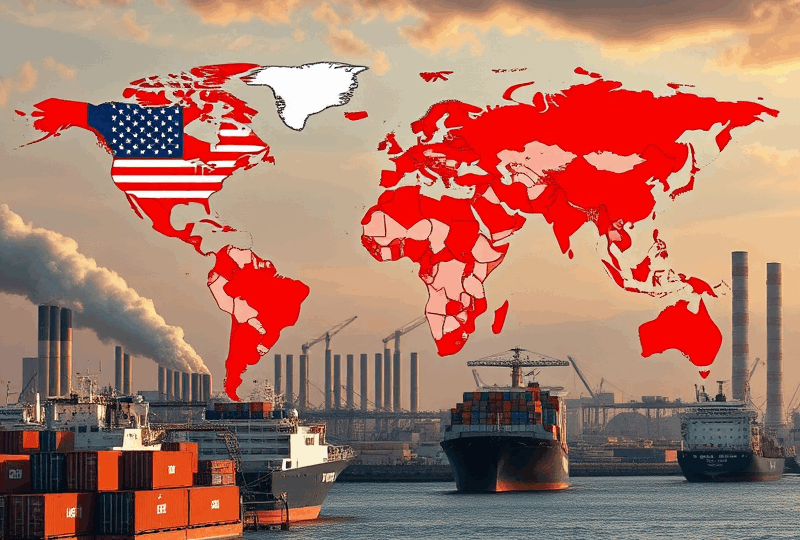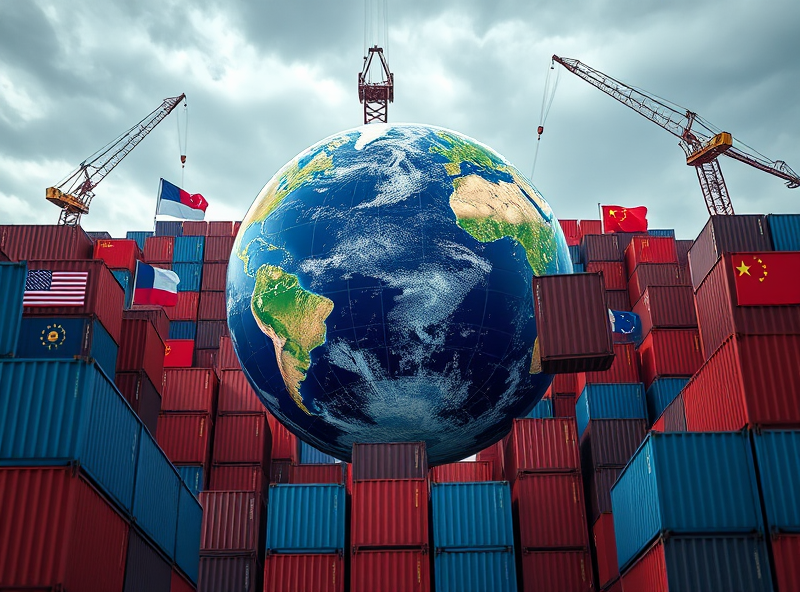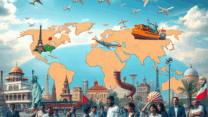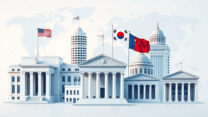
The Rise of Protectionism: Global Trade at Risk

Hello, fellow global citizens and observers of the world economy! Have you noticed how conversations about international trade seem to be getting a bit more complicated lately? It feels like we’re hearing more about tariffs, trade disputes, and countries focusing on producing goods closer to home. For decades after World War II, the world generally moved towards greater free trade, lowering barriers and making it easier for goods and services to flow across borders. This era of globalization brought many benefits, but it also created new challenges. Now, there’s a noticeable shift happening – a rise in what’s known as protectionism. This trend involves countries implementing policies designed to protect their domestic industries and workers from foreign competition. You might wonder, “Why is this happening now?” or “How does this affect the prices I pay or the availability of goods?” or “What does this mean for the global economy as a whole?” You’re asking questions that are at the forefront of international economic discussions! The purpose of this article is to explore the rise of protectionism, delve into its causes, explain the tools countries use, and discuss the significant risks it poses to global trade and economic prosperity. Let’s uncover the forces behind this shift and understand its potential consequences for our interconnected world.
What Exactly is Protectionism?
At its core, protectionism is an economic policy approach where a country uses various methods to restrict imports from other countries and often promote domestic production. The goal is typically to shield domestic industries, businesses, and jobs from foreign competition. Proponents argue that these measures help nurture nascent industries, protect national security interests, or prevent unfair trade practices by other countries. However, critics argue that protectionism ultimately harms consumers by limiting choice and raising prices, reduces overall economic efficiency, and can lead to retaliation from other countries, escalating into damaging trade wars. Unlike free trade, which advocates for minimal barriers to international commerce, protectionism actively seeks to manage and often limit the flow of goods and services across borders.
A Look Back: Cycles of Trade
The history of global trade is not a straight line towards ever-increasing openness. It has seen periods of both greater protectionism and greater liberalization. In the period leading up to the Great Depression, many countries adopted highly protectionist policies, such as imposing high tariffs, which are widely believed to have worsened the economic downturn and contributed to international tensions. Following World War II, there was a concerted effort, led by the United States, to build an international system based on cooperation and reduced trade barriers. Institutions like the General Agreement on Tariffs and Trade (GATT), which later evolved into the World Trade Organization (WTO), were established to promote multilateral trade agreements and resolve disputes. This era saw a significant reduction in tariffs and other trade barriers, contributing to a surge in global trade and economic interdependence. However, even during this period, protectionist pressures never entirely disappeared, often resurfacing during economic downturns or when specific industries faced intense foreign competition. The current rise in protectionism can be seen, in part, as a reaction to some of the consequences of globalization and a return to more nationally focused economic policies.
Why the Recent Rise in Protectionism?
Several interconnected factors are contributing to the recent increase in protectionist sentiment and policies around the world:
- Economic Nationalism: In many countries, there’s a growing emphasis on prioritizing domestic economic interests above global integration. This can stem from a belief that past trade policies have led to job losses or harmed specific sectors within the country. Political leaders may gain support by promising to protect domestic industries and bring back manufacturing jobs.
- Concerns About Job Losses: Globalization and increased competition from countries with lower labor costs have led to job displacement in certain industries in developed nations. While free trade advocates argue that globalization creates new jobs in other sectors, the concentration of job losses in specific communities or industries can fuel political pressure for protectionist measures.
- Trade Imbalances: Large and persistent trade deficits (where a country imports significantly more than it exports) are often cited as a reason for implementing protectionist policies. Policymakers may believe that restricting imports is a way to reduce these imbalances, although economists often point to broader macroeconomic factors like national savings and investment rates as the primary drivers of trade balances.
- National Security Concerns: Countries are increasingly concerned about relying on foreign suppliers for goods deemed critical for national security, such as defense equipment, pharmaceuticals, or essential technologies. This has led to policies aimed at promoting domestic production or diversifying supply chains to reduce dependence on potential adversaries.
- Supply Chain Resilience: Recent global events, such as the COVID-19 pandemic and geopolitical disruptions, highlighted the vulnerability of long, complex global supply chains. Shortages of essential goods (like medical supplies or semiconductors) spurred calls for bringing production closer to home (nearshoring or reshoring) to ensure greater reliability and resilience in times of crisis.
- Political Factors: Protectionist rhetoric can be politically popular, especially in regions that have been negatively impacted by global competition. Politicians may use protectionist promises to appeal to voters who feel left behind by globalization.
- Perceived Unfair Trade Practices: Countries may implement protectionist measures in response to what they perceive as unfair trade practices by other nations, such as currency manipulation, intellectual property theft, or excessive state subsidies to domestic industries. These actions can trigger retaliatory measures, leading to escalating trade tensions.
These factors often interact, creating a complex environment where the political desire for protectionism gains traction.
The Tools of Protectionism
Countries employ a variety of tools to implement protectionist policies. These measures aim to make imported goods and services more expensive or more difficult to obtain:
- Tariffs: This is the most common protectionist tool. A tariff is a tax or duty imposed on imported goods. When a tariff is applied, the cost of the imported good increases, making it less competitive compared to domestically produced goods. Tariffs can be specific (a fixed amount per unit) or ad valorem (a percentage of the value of the good). For example, imposing a tariff on imported steel makes foreign steel more expensive, potentially encouraging domestic manufacturers to buy steel produced within the country.
- Import Quotas: An import quota is a quantitative restriction on the amount of a specific good that can be imported into a country during a certain period. Quotas directly limit the supply of imported goods, which can lead to higher prices for consumers due to reduced availability and less competition for domestic producers.
- Subsidies: Governments can provide financial assistance (subsidies) to domestic industries to help them compete with foreign producers. Subsidies can take various forms, such as direct payments, tax breaks, or low-interest loans. Subsidies lower the production costs for domestic companies, allowing them to sell their goods at lower prices than foreign competitors, even without tariffs or quotas on imports.
- Non-Tariff Barriers (NTBs): These are regulations, standards, or bureaucratic procedures that make it more difficult or costly to import goods, even if there are no tariffs or quotas. Examples include:
- Strict product standards: Requiring imported goods to meet specific safety, health, or environmental standards that differ from international norms, forcing foreign producers to incur extra costs to comply.
- Burdensome customs procedures: Complex or slow customs processes that delay imports and increase costs for importers.
- Domestic content requirements: Mandating that a certain percentage of a product’s components must be domestically sourced.
- Government procurement policies: Giving preference to domestic suppliers in government purchasing decisions.
NTBs can be less visible than tariffs but can be just as effective in restricting trade.
- Currency Manipulation: While not a direct trade barrier, a country can manipulate its currency exchange rate to make its exports cheaper and imports more expensive, effectively acting as a subsidy for exports and a tax on imports.
Countries often use a combination of these tools to achieve their protectionist goals.
The Economic Impacts of Rising Protectionism
The rise of protectionism poses significant risks to the global economy. While intended to protect domestic interests, these measures often have negative consequences that can outweigh the benefits:
- Reduced Global Trade Volume: Protectionist measures directly restrict the flow of goods and services across borders. Tariffs make imports more expensive, reducing demand. Quotas limit the quantity of imports. This leads to a decrease in the overall volume of international trade, which can slow down economic activity globally.
- Higher Consumer Prices: Tariffs and quotas increase the cost of imported goods. Domestic producers, facing less competition from imports, may also raise their prices. This means consumers end up paying more for a wide range of products, from cars and electronics to clothing and food. This reduces consumers’ purchasing power and lowers their standard of living.
- Reduced Economic Efficiency: Free trade allows countries to specialize in producing goods and services where they have a comparative advantage (can produce more efficiently). Protectionism interferes with this specialization, leading countries to produce goods domestically that could be produced more efficiently and cheaply elsewhere. This results in a less efficient allocation of global resources and lower overall economic output.
- Retaliation and Trade Wars: When one country imposes protectionist measures, other countries are likely to retaliate by imposing their own tariffs or barriers on the first country’s exports. This can escalate into a trade war, where multiple rounds of tariffs and counter-tariffs severely disrupt trade flows, harm businesses, and reduce economic growth in all involved countries.
- Disruption of Global Supply Chains: Modern manufacturing often relies on complex global supply chains, where components are sourced from various countries. Tariffs and trade barriers can disrupt these supply chains, making it more expensive or difficult for businesses to obtain necessary parts, leading to higher production costs and potential delays. While some protectionist measures aim to shorten supply chains for resilience, the sudden imposition of barriers can be highly disruptive in the short term.
- Slower Global Economic Growth: The combination of reduced trade, higher costs, decreased efficiency, and increased uncertainty caused by protectionism can lead to slower economic growth not just for the countries involved in disputes, but for the global economy as a whole. International organizations like the IMF and WTO frequently warn about the negative impact of rising protectionism on global growth prospects.
- Reduced Innovation: Competition from foreign firms can spur domestic companies to innovate and become more efficient. Protectionism reduces this competitive pressure, potentially leading to less innovation and slower productivity growth in protected industries.
These negative impacts highlight why economists generally favor free trade and view protectionism as detrimental to long-term economic prosperity.
Impact on Businesses and Consumers
Let’s look specifically at how businesses and consumers are affected:
- Businesses:
- Increased Costs: Businesses that rely on imported raw materials or components face higher costs due to tariffs.
- Reduced Market Access: Businesses that export their goods face tariffs and other barriers in foreign markets, making it harder to sell their products abroad.
- Supply Chain Uncertainty: Trade disputes and the threat of new barriers create uncertainty for businesses managing global supply chains.
- Potential Domestic Advantage (for protected industries): Businesses in industries that receive protection (e.g., through tariffs on imports) may see increased domestic sales and potentially higher profits due to reduced foreign competition. However, this can come at the expense of domestic consumers and businesses in other sectors.
- Consumers:
- Higher Prices: Consumers pay more for imported goods and potentially for domestically produced goods that face less competition.
- Less Choice: Restrictions on imports can reduce the variety of goods available to consumers.
- Reduced Purchasing Power: Higher prices mean consumers’ money doesn’t go as far, reducing their overall purchasing power.
While some workers in protected industries might benefit from job security, the overall impact on the economy is often negative, with costs spread across many consumers and businesses, while benefits may be concentrated in specific sectors.
Geopolitical Implications: Trade Tensions and Relationships
Beyond economics, the rise of protectionism has significant geopolitical implications. Trade disputes can strain relationships between countries, even allies. When countries impose tariffs on each other, it can create resentment and make cooperation on other international issues more difficult. Trade wars can become entangled with broader geopolitical rivalries, increasing global instability. The multilateral trading system, centered around the WTO, relies on countries adhering to agreed-upon rules and resolving disputes through negotiation. Rising protectionism and unilateral actions (like imposing tariffs outside of WTO rules) can undermine this system, making it harder to manage global trade relations peacefully and predictably. The shift towards prioritizing national interests in trade can lead to a less cooperative and potentially more confrontational international environment.
Navigating a More Protectionist World
Given the current trend, how can businesses, policymakers, and individuals navigate a world with increasing protectionist pressures?
- For Businesses:
- Diversify Supply Chains: Reduce reliance on single countries for critical components or production. Explore sourcing from multiple regions to build resilience against trade disruptions.
- Seek New Markets: If facing barriers in one market, explore opportunities in others.
- Focus on Domestic Competitiveness: Invest in innovation, technology, and workforce skills to improve efficiency and competitiveness regardless of trade barriers.
- Engage in Advocacy: Businesses impacted by protectionism may need to engage with policymakers to voice their concerns.
- For Policymakers:
- Pursue Diplomatic Solutions: Seek negotiated solutions to trade disputes rather than unilateral actions.
- Invest in Domestic Competitiveness: Address the root causes of job concerns by investing in education, infrastructure, and support for workers transitioning between industries.
- Strengthen International Cooperation: Work through international bodies like the WTO to update trade rules and resolve disputes.
- Consider Targeted, Temporary Measures (with caution): If protection is deemed necessary for specific strategic industries, ensure measures are targeted, transparent, and temporary to minimize broader economic harm and avoid retaliation.
- For Individuals/Consumers:
- Stay Informed: Understand how trade policies can impact the prices you pay and the availability of goods.
- Understand the Broader Economic Picture: Recognize that while protectionism might benefit a specific local industry, it can have wider costs for the economy as a whole.
Adapting to this changing trade landscape requires flexibility, strategic planning, and a clear understanding of the potential consequences of protectionist actions.
The Future of Global Trade: Resilience Under Pressure
The rise of protectionism is putting pressure on the global trading system that has been built over decades. While a complete reversal of globalization is unlikely, the trend towards greater trade barriers and more nationally focused economic policies appears set to continue in the near term. This doesn’t mean the end of global trade, but it suggests a future where trade flows might be less free, supply chains are reconfigured for resilience as well as efficiency, and trade tensions remain a significant factor in international relations. The ability of international institutions to manage these tensions and promote cooperation will be severely tested. The conversation is shifting from simply maximizing efficiency through free trade to balancing efficiency with resilience, national security, and domestic concerns. Navigating this evolving landscape will require careful consideration and strategic adaptation from all participants in the global economy.
Understanding Protectionism: A Key to the Global Economy
In conclusion, the rise of protectionism is a significant trend reshaping the global economic landscape. Driven by factors like economic nationalism, job concerns, and supply chain vulnerabilities, countries are increasingly using tools like tariffs, quotas, and subsidies to protect domestic industries. While intended to benefit specific sectors, these measures pose substantial risks to global trade, leading to reduced trade volumes, higher consumer prices, decreased efficiency, and the potential for damaging trade wars. Understanding the causes and consequences of protectionism is crucial for businesses, policymakers, and informed citizens alike. As the global economy navigates this period of increased trade tensions, adapting strategies for resilience and seeking cooperative solutions will be essential for fostering continued, albeit potentially different, global economic engagement. Staying informed about these trends is vital for understanding the forces shaping our interconnected world. Wishing you insight and clarity as you observe the dynamics of global trade! 😊







